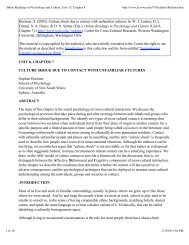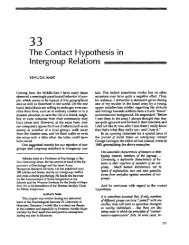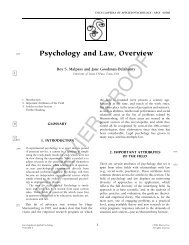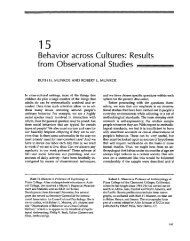From the Lab to the Police Station - Eyewitness Identification Lab ...
From the Lab to the Police Station - Eyewitness Identification Lab ...
From the Lab to the Police Station - Eyewitness Identification Lab ...
Create successful ePaper yourself
Turn your PDF publications into a flip-book with our unique Google optimized e-Paper software.
Gary L. Wells<br />
in psychology addressing eyewitness reliability issues<br />
(Cutler & Penrod, 1995).<br />
A major difference between Mtinsterberg's approach<br />
and <strong>the</strong> modern eyewitness literature concerns <strong>the</strong> distinction<br />
between system variables and estima<strong>to</strong>r variables<br />
(Wells, 1978). Mtinsterberg (1908) described <strong>the</strong> potential<br />
contribution of psychology in terms of postevent assessment<br />
(i.e., assessing <strong>the</strong> validity of an individual eyewitness<br />
account at <strong>the</strong> trial phase). Mtinsterberg emphasized<br />
how psychologists might identify eyewitness errors after<br />
<strong>the</strong>y have already occurred. Beginning in <strong>the</strong> late 1970s, a<br />
new perspective emerged that described psychology's contribution<br />
as preventing eyewitness errors from occurring in<br />
<strong>the</strong> first place ra<strong>the</strong>r than postdicting errors after <strong>the</strong> fact<br />
(Wells, 1978). This new perspective argued that some<br />
variables (system variables) affect <strong>the</strong> accuracy of eyewitness<br />
accounts over which <strong>the</strong> justice system has control,<br />
whereas o<strong>the</strong>r variables (estima<strong>to</strong>r variables) are beyond<br />
<strong>the</strong> control of <strong>the</strong> justice system. For example, labora<strong>to</strong>ry<br />
experiments indicate that <strong>the</strong> presence of a weapon draws<br />
attention away from a perpetra<strong>to</strong>r's face and lowers <strong>the</strong><br />
chances that witnesses can later identify <strong>the</strong> perpetra<strong>to</strong>r<br />
(Kramer, Buckhout, & Eugenio, 1990; Loftus, Loftus, &<br />
Messo, 1987; Maas & Kohnken, 1989). The weapon effect,<br />
however, is an estima<strong>to</strong>r variable because <strong>the</strong> justice system<br />
can only estimate (not control) <strong>the</strong> influence that stress<br />
might have had on an eyewitness. The structure of a lineup,<br />
on <strong>the</strong> o<strong>the</strong>r hand, is a system variable because <strong>the</strong> system<br />
controls how lineups are structured, which in turn has an<br />
effect on <strong>the</strong> accuracy of <strong>the</strong> eyewitness. Research on both<br />
types of variables has been important <strong>to</strong> psychologists'<br />
understanding of eyewitness errors. However, <strong>the</strong> development<br />
of a scientific literature on system variables was<br />
unique in being able <strong>to</strong> inform <strong>the</strong> justice system of ways<br />
<strong>to</strong> increase <strong>the</strong> accuracy of eyewitness statements in general<br />
and decrease <strong>the</strong> frequency of identification errors in<br />
particular.<br />
The development of a scientific literature on eyewitness<br />
system variables began in <strong>the</strong> late 1970s and flourished<br />
in <strong>the</strong> 1980s and 1990s. This research can be placed<br />
in<strong>to</strong> two broad categories corresponding roughly <strong>to</strong> recall<br />
and recognition memory but usually dubbed event memory<br />
and identification memory. Event memory refers <strong>to</strong> <strong>the</strong><br />
ability of eyewitnesses <strong>to</strong> describe details of a critical<br />
event, such as whe<strong>the</strong>r a perpetra<strong>to</strong>r used <strong>the</strong> right hand or<br />
left hand <strong>to</strong> hold a gun, <strong>the</strong> color of a getaway car, or a style<br />
of clothing worn by a perpetra<strong>to</strong>r. <strong>Identification</strong> memory<br />
refers <strong>to</strong> <strong>the</strong> ability of eyewitnesses <strong>to</strong> select a perpetra<strong>to</strong>r<br />
from a set of pho<strong>to</strong>s or a live lineup.<br />
Event Memory System Variables<br />
<strong>Eyewitness</strong> researchers have identified several system variables<br />
that affect <strong>the</strong> accuracy and completeness of eyewitness<br />
accounts of events. Loftus's (1979) early work, for<br />
example, showed that eyewitness accounts can be affected<br />
by exposure <strong>to</strong> misleading questions, a system variable.<br />
Loftus's influential work was provocative because it depicted<br />
eyewitness memory as being malleable and shaped<br />
by events that occur after a person witnesses an event.<br />
Psychologists directed considerable amounts of research at<br />
<strong>the</strong> misleading question effect for several important <strong>the</strong>oretical<br />
reasons that were largely independent of a concern<br />
over system variables. For instance, <strong>the</strong> misleading question<br />
effect went <strong>to</strong> <strong>the</strong> very heart of <strong>the</strong> question of whe<strong>the</strong>r<br />
long-term memories were s<strong>to</strong>red permanently in <strong>the</strong> brain<br />
or were subject <strong>to</strong> alteration or replacement after being<br />
s<strong>to</strong>red (see Loftus & Loftus, 1980). Several researchers<br />
offered alternative interpretations of <strong>the</strong> effect's cause,<br />
such as compliance, competing memories, and so on (e.g.,<br />
see Berkerian & Bowers, 1983; McCloskey & Zaragoza,<br />
1985). Some of <strong>the</strong> <strong>the</strong>oretical controversy on <strong>the</strong>se matters<br />
remains unresolved <strong>to</strong>day, but from a system-variable perspective<br />
<strong>the</strong> issues are not controversial at all. The scientific<br />
proof is compelling that eyewitnesses will make systematic<br />
errors in <strong>the</strong>ir reports as a function of misleading<br />
questions (or as a result of o<strong>the</strong>r incorrect postevent sources<br />
of information). <strong>From</strong> a system-variable perspective, it<br />
matters little whe<strong>the</strong>r this effect is a result of introducing<br />
new memories or altering old memories or whe<strong>the</strong>r this is<br />
a compliance phenomenon. The important point is that<br />
witnesses will extract and incorporate new information<br />
after <strong>the</strong> witnessed event and <strong>the</strong>n testify about that information<br />
as though <strong>the</strong>y had actually witnessed it.<br />
In <strong>the</strong> 1980s, Ronald P. Fisher and Ed Geiselman<br />
attempted <strong>to</strong> apply psychological research <strong>to</strong> eyewitness<br />
event memory in a way that could be used directly by<br />
police investiga<strong>to</strong>rs. Their analysis of American police<br />
interviews of cooperative eyewitnesses revealed that police<br />
make systematic, avoidable errors that limit <strong>the</strong> amount of<br />
information <strong>the</strong>y elicit (Fisher, Geiselman, & Raymond,<br />
1987; see also George & Clifford, 1992, for similar errors<br />
by British police). Some of <strong>the</strong> more flagrant errors are (a)<br />
asking <strong>to</strong>o many closed-ended questions and <strong>to</strong>o few open-<br />
582 June 2000 ° American Psychologist







